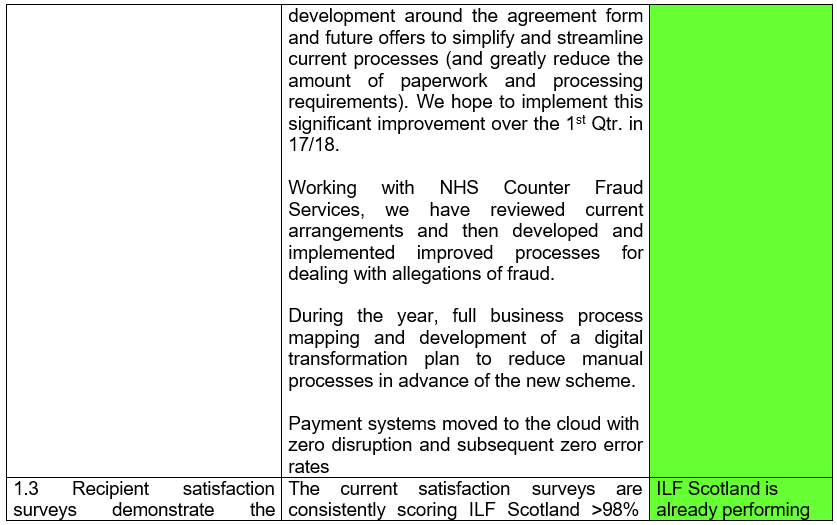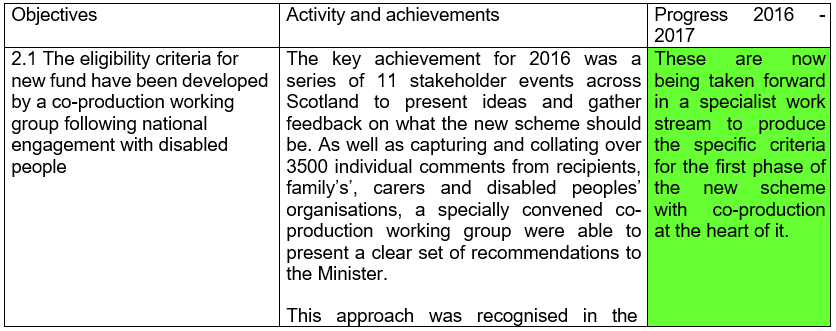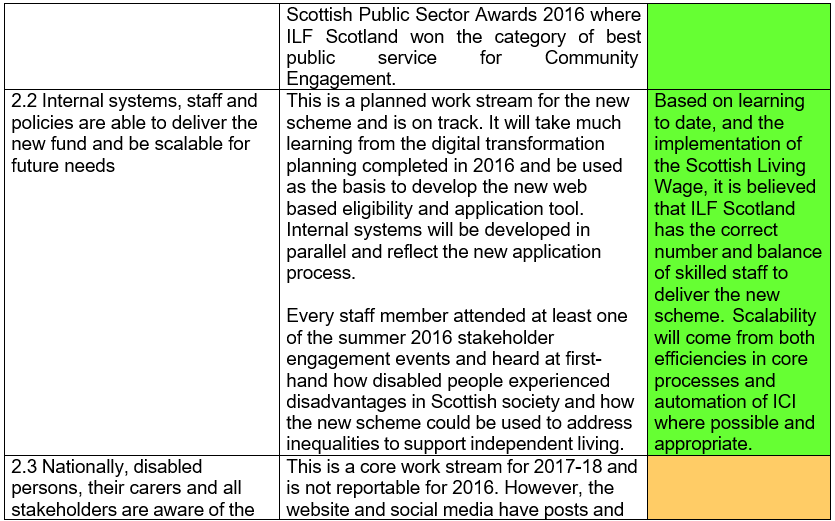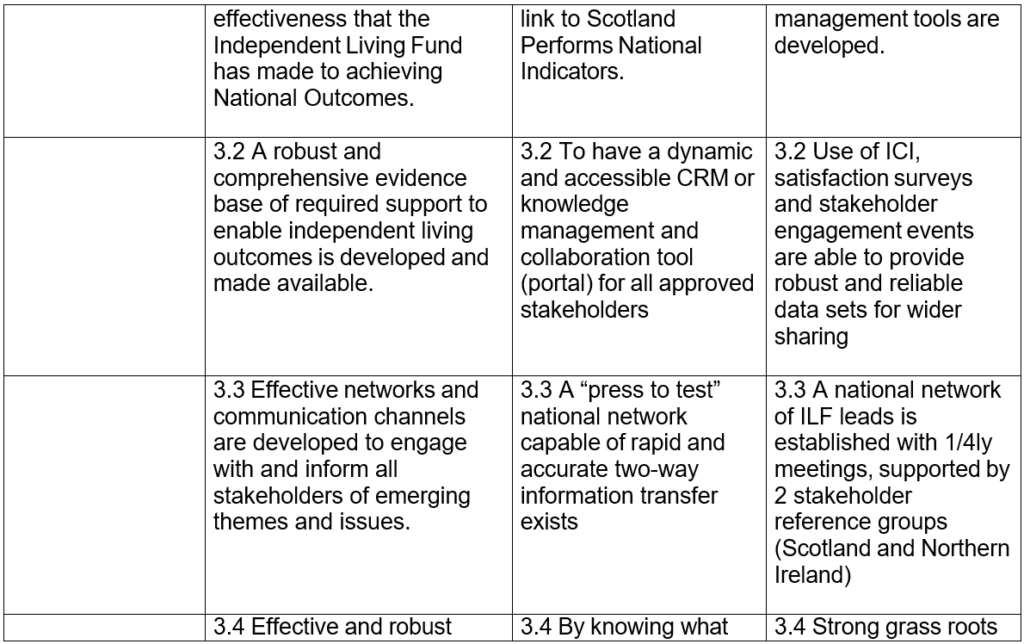
Contents
| 1. Introduction | 3 |
| 2. Executive Summary | 3 |
| 3. Performance Framework | 9 |
| 4. Strategic Priority 1 – Maximise the effective value of the fund | 11 |
| 5. Strategic Priority 2 – Implement the New Scheme | 23 |
| 6. Strategic Priority 3 – Share our knowledge to develop best practice across Scotland | 27 |
| 7. Our People | 20 |
| Annex A Key Statistics | 23 |
| Annex B Proposed KPIs 2017 – 2018 | 30 |
The purpose of this report is to provide a summary of achievement and activities from April 2016 – March 2017 including specific details relating to Quarter 4 against our organisational strategy.
i. Overview - Over the past 12 months ILF Scotland has become a multi-award winning public body, going from strength to strength and making significant progress in delivering the first year of the organisational strategy agreed in 2016. This is despite a backdrop of huge change in every facet of society, continued austerity, changing legislation and increasing pressure on public services. Throughout the this period we have also been conscious of continuing to support the successful delivery of the pubic commitments made by the Scottish Government in relation to ILF funding, namely that: -
ii. Main Effort - The main effort from an operational perspective was to: catch-up on the backlog of assessment visits inherited from the transfer of responsibilities from the UK wide ILF in July 2015; implement the Scottish Living Wage; and prepare for opening a new broad based independent living scheme later in 2017. This is alongside work to further strengthen of our critical foundations, improving business as usual systems and establishing ILF Scotland firmly into the fabric of public service delivery in Scotland and Northern Ireland.
iii. Operational Performance - Current fund recipient numbers have dropped by 155 to 3119 (Scotland – 2519 & NI – 528) over 16/17. This follows the trend of around 4-5 % of recipients leaving the fund on an annual basis as was the case in 2015/16. Even though overall numbers have fallen, the tempo of operational activity around visits has increased significantly, with 1,690 visits being allocated, 1,799 reports received and 2,261 new offers made in 16/17. Some of the increase is down to the implementation of the Scottish Living Wage (SLW), where additional offers have been made, however on a like for like basis (15/16 was only a 9 months operating period), there has been an 89% increase in terms of work carried out from the previous year. As a consequence of this progress and hard work, we will have caught up on the backlog of inherited assessments from the transfer from ILF to ILF Scotland in the first quarter 17/18.
iv. Call Volumes - Call and email volumes, have slightly increased from 6,122 in 15/16 (5,330 telephone and 792 email enquiries) to 9,332 in 16/17 (8,347 telephone and 895 email enquiries). This is a like for like increase of 14% year on year with over 85% of all enquiries relating to Scotland. The main areas of query are as follows:
v. Scottish Living Wage Implementation - Due to the incredible complexity in adapting our systems and getting agreement on our approach from the Scottish Government’s ILF Scotland Sponsor Team, we are slightly behind in completing the uplift of additional funds in relation to the Scottish Living Wage. The delivery of this commitment is well under way with 95% of recipients who employ personal assistant employees being processed with a new offer relating to the increase in their award. We expect this part to be fully complete including the additional uplift from £8.25 to £8.45 by the end of April 17. Alongside that we have done all the preparatory work to provide additional funding to support recipients who use agencies and as agreement to proceed was received at the end of March, we expect this element to be completed by the end of May 17. The only individuals not uplifted, are those that would breach the maximum weekly amount as their current award is already near the upper limit. In those circumstances, we are prioritising a review to see how their package of support can be reshaped to limit a negative impact. For further information please see the risk register.
vi. Recipients - What continues to be reinforced through all our activities and highlighted in previous reports, is the challenging time disabled people are having in trying to have choice and control about decisions in their lives. This is mainly due to the upward cost pressures centred on increases in the statutory national minimum wage and Scottish Living Wage, statutory sick pay, pension’s auto-enrolment, sleepovers and the cost of living against a backdrop of wider public
sector austerity. As a consequence of this we have invested considerable organisational focus at protecting the additionality of ILF support to enable independent living.
vii. Feedback - Feedback about how ILF Scotland is doing has gone up slightly from 98% in 15/16 (76 responses representing 13% of all offers made) to 99% in 2016/17 (186 responses representing 9% of all offers made). Coupled with this we received 6 complaints which related to the policies inherited and represented 0.3% of all offers made.
viii. Digital Transformation and Continuous Improvement – The final quarter of this year has seen a change in approach to our digital transformation with the focus now on developing our core ICI system to accept and process applications for the new scheme. The bulk of the work has been completed for the longer term digital transformation, including the comprehensive business requirements documents prepared with our colleagues at Digital Transformation Service (DTS) during 2016. These requirements remain valid and, in effect, we will cherry pick what we are able to from them to deliver the new scheme later this year. Depending on the success of making ICI web ready, there is the opportunity to adopt many of the transformational business requirements into ICI once the new scheme has been operationalized. This could potentially save ILF Scotland several hundred thousands of pounds for its longer term technical development towards SG2020.
ix. New Scheme - Much of the ground work for initiating the new scheme has happened in this last quarter with the project board and implementation teams coming together. There are 6 interlinked work streams, each with a key lead, and embracing co-production where possible to add value. The critical work stream is developing the new eligibility criteria for the first phase of the new scheme and once these are known, greater progress can be made on partnership development, communication and information resources and the technical configuration. Of note, there will be an external independent evaluation following the implementation and their reporting will inform and assist the development of further phases of the scheme.
x. Awards and Accreditation – The work carried out by the ILF Team has been recognised with various prestigious awards and through accreditation, a summary is as follows:
xi. Finance - Overall this has been an impressive year from a finance perspective building on the results from 15/16. Management accounts and detailed internal audit recommendations for this period are covered separately from this document; however the key activities of note carried out are shown below:
As a consequence of the above, we have achieved the following:
Finally through robust assessment and controls we have identified 4 cases of misuse of funds, suspected fraud and provider overcharging of recipients. This represents a potential fraud risk of 0.2% on a part of funding disbursed against all cases reviewed this year which is broadly similar with 15/16. A separate report has been presented to the Audit and Risk Committee.
xii. Social Work – This has been an extremely busy year for the social work team with two key areas of activity – review visits and relationship building. Of particular reporting relevance has been the joint work with the policy team and the issuing of a new Policy and Practice Circular with 37 local authority or health and social care partnerships – this is now seeing a fairer and more consistent application of the suite of ILF Scotland policies on a national level across both Scotland and Northern Ireland. The key achievements are:
xiii. Policy – The work of the policy team alongside the social work team this year has seen much greater consistency and harmonisation across the whole suite of policies culminating in the issue of the new Policy and Practice Circular in January 2017. The key achievements for the policy team have been:
xiv. Corporate Communications – Significant progress has been made in the area of corporate communications over this reporting period with a 61% increase in website views year of 22,613 in 15/16 to 33,619 in 16/17. Twitter followers have more than doubled from 359 in 15/16 to 719 in 16/17 and our Facebook presence has gone from 20 likes to 81. On a like for like basis this is 13% increase in online activity from the previous year. Alongside this, other key activities have included;
xv. Summary - Though we achieved a huge amount over the last quarter and year, the main priorities we will focus on next year are as follows:
We have designed the ILF Scotland strategy to align with both the national performance framework for Scotland www.gov.scot/About/Performance/scotPerforms and the draft Performance for Governance Northern Ireland Draft Programme for Government Framework 2016-2021 (northernireland.gov.uk).
Specifically, the work of ILF Scotland contributes to the 3 Scottish National Outcomes of
The 16 objectives of the strategic plan contribute either directly or indirectly to the following National Indicators. Through internal quality assurance and the use of satisfaction surveys, the intention is to now make the linkages more explicit in external reporting in 2017 – 18. Collectively they are indicators of sustainability and demonstrate positive progress in reducing inequalities and increasing participation in all aspects of Scottish and Northern Irish life.

This priority is about being as effective as possible in all our process to ensure that administration overheads are kept to a minimum to maximise the effective value of the fund at all times. During the period much work has been done to identify internal process efficiencies and to reduce funding duplication and resource transfer with statutory services.
The digital transformation process, new counter fraud initiatives and redefinition of the legal contract between ILF Scotland and award recipients have been progressed this year and set the basis for further process and environmental savings going forward.
One key aspect to this priority has been the development of a new performance management framework aligned to Scottish Government National Indicators. Much consideration has been given to how business intelligence and management information reporting systems can be used to improve our practices as we move forward with the implementation of the new scheme. A draft set of proposed targets and KPIs for discussion with the Board are offered at Annex B.
Overall this priority is assessed as Green (on track) and the planned efficiencies going forward will aim to see the new scheme implementation met with no additional staffing resources.









This priority is on track and proceeding well. Further to the stakeholder engagement events during summer 2016, the groundwork has been prepared and clear recommendations made on what the new scheme will deliver. Much of the project management has been planned in the last quarter and the project board and work stream leads assembled ready to implement the recommendations during 2017.
The new scheme will follow a ‘Phase to Learn’ approach with subsequent phases based on independent external evaluation from the first phase. This project, as well as being a key strategic priority for ILF Scotland, will increase the reach and impact of support for disabled people in Scotland and help achieve Scottish National Indicators for reducing inequalities and increasing participation. Of note, the project has brought together key expert stakeholders to inform the policy development and ensure equity and rights are maximised as much as possible. As ILF Scotland has not been open to receive new applications, this will be both an interesting and challenging priority but is assessed as Green (on track) due to the preparatory work completed in this reporting period.



The vision of ILF Scotland is to make independent living a reality for disabled people living in Scotland and Northern Ireland. On our own, we are not able to achieve this but through partnership working, collaboration and sharing best practice, our aim is to ensure all those providing support can learn from our experiences and extend their own practices.
This has been a particularly busy year for all at ILF Scotland and the key activities of review visits and relationship development with statutory services and local authorities has embedded our values and practices across Scotland and Northern Ireland.
Based on current credibility and successes, implementing the new scheme will provide much opportunity to gather more evidence and share our practices with a wider network. The overall priority is assessed as Amber as the two key objectives of learning from the new surveys and the evaluation from the new scheme have not occurred in this reporting period but are well advanced to inform the next report.





a. Overview – In the past year we have continued to strengthen our approach and systems relating to HR and organisational development, to ensure our employee proposition is inclusive, people friendly and market leading. These efforts have been externally endorsed by being a finalist in the category of ‘Best Public Sector Employer’ at the Family Friendly Scotland awards in March 17 and winning the David Drysdale Memorial Award at the same event from Fathers Network Scotland.
b. Organisational Demography - By the year end, the organisational make up consists of 46 staff and Directors who are engaged in a combination of part-time, full-time contracts and freelance contracts. The current gender mix is 67:33 female: male, with 15% of staff registered disabled, 9% BME and 6% LGBT.
c. Recruitment - Since April 2016, 3 x Directors have joined the Board and we have strengthened the staff team with the following appointments:
d. Employment status - To foster a people friendly approach, ILF Scotland offers different contractual opportunities to all individuals employed in some capacity with the organisations. In January 2017 4 x Assessors (3.6 FTE) changed their contract status from freelance to employed.
e. Retention - Staff retention has been strong throughout the year, with only 1 x Freelance Assessor leaving for personal reasons and the IT & Development Manager leaving due to remuneration inequity and parity to the Scottish Government.
f. Absence – Sickness rates have been extraordinarily low in the last 12 months, indeed since the organisation went operational in 2015. The current rate is 2.66 days per annum, which compares extremely favourably against CIPD’s 2016 sector analysis, showing public sector employees take an average of 8.5 days. If you strip out such incidences as three other episodes of extremely serious illness, there would have had around 1.5 days lost to absence in the last 12 months.
g. Disciplinary, Grievance and Performance - No issues to report.
h. Staff Survey – 90% of staff participated in an employee survey that was carried out at the end of 2016. The findings of this survey were published internally to all staff and Directors. It found that there was a strong sense of culture and feeling valued, with a 95+% satisfaction rate around family- and life-friendly practices. That said it highlighted opportunities for improvement around internal communication and growing frustration at the length of time it has taken to put in place fair and equitable remuneration in comparison with the rest of the Scottish Public Sector. The imp[act of the delay in putting a pay structure in place, has been the resignation of the IT & Development Manager, which has not only incurred additional cost to bridge the gap, but also a reduction in organisational ability at a critical time. This proposal has been sitting with the Scottish Government Sponsor Team since August 16, with no formal response. Despite significant effort by the ILF Scotland Board and SMT, there has been little progress with resolving this. As a consequence of this, there is a real growing frustration and anger amongst staff who feel that they are being treated unfairly. The goodwill and trust from all staff that has been a hallmark of the organisation and a key contributor to the success, is being eroded quickly. If this is not resolved satisfactorily and quickly, it will result in staff leaving at the very least, potential increased costs, reduction of capability through a key development phase, a knock on effect to other risk areas and if these materialise, possible reputational damage to SG and NI Governments.
i. Supporting Activity - to enable the organisation to successfully deliver the strategy and be an employer of choice, the following activity has taken place:
j. Health and Safety - An annual audit of the organisational health and safety framework has been completed and no areas of improvement were highlighted. In the last year, we have had one minor accident where a member of staff was bitten by a recipient’s pet.
The following tables show the key statistics for the period 1st April 2016 to 31st March 2017 and are aligned to standard annual financial reporting cycles as ILF Scotland is now in steady state operations.
a. Table 1: Payments to ILF Scotland Recipients


b. Table 2: ILF Scotland Recipients

c. Table 3: Visits Allocated, Reports Received and Offers Made

d. Table 4: Decision Review, Complaints and Panels (Appeals)

e. Table 5: General Statistics

f. Recipient Satisfaction Survey Results

g. Corporate Communication Statistics


“Our vision is for independent living to be a reality for all disabled people living in Scotland and Northern Ireland.”
In working towards this vision, we aim to be: -
The proposed targets are the future state aspiration of where we want to be. The KPIs are quarterly or annual measurement tools which will indicate if we are on track, ahead or behind where we should be to achieve the targets by the end of this strategic plan. The intention would then be to use these targets and KPIs for future metric reporting and analysis. These initial draft KPIs will act as a catalyst for discussion as the framework for a development day with the directors and senior team. It is planned to agree and refine these ready for reporting in early 17/18.









